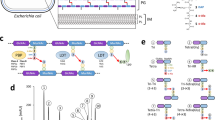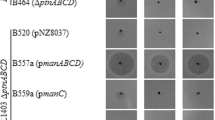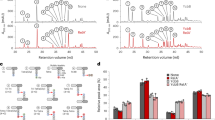Abstract
Fusaricidin, a lipodepsipeptide isolated from Paenibacillus polymyxa, has high antimicrobial activity against fungi and Gram-positive bacteria. Through mutagenesis, we obtained two mutant strains, N1U7 and N17U7, which produce 6.2- to 7.9-fold more fusaricidin than their parent strain. Causal mutations were identified by whole-genome sequencing, and the two strains each contained at least eleven point mutations, including four common mutations. A mutation in the PPE04441 gene (pgm), encoding an α-phosphoglucomutase, was found to be an important factor in fusaricidin overproduction by complementation experiments. Null mutation of pgm in the parental strain increased fusaricidin production by 5.2-fold. Increased growth and cell viability in stationary phase, reduced exopolysaccharide production, and increased fusA expression were observed in the pgm mutant strains, which might be related to fusaricidin overproduction. This is the first report revealing that PGM deficiency leads to an overproduction of fusaricidin.



Similar content being viewed by others
References
Arbeit RD, Maki D, Tally FP, Campanaro E, Eisenstein BI (2004) The safety and efficacy of daptomycin for the treatment of complicated skin and skin-structure infections. Clin Infect Dis 38:1673–1681
Beatty PH, Jensen SE (2002) Paenibacillus polymyxa produces fusaricidin-type antifungal antibiotics active against Leptosphaeria maculans, the causative agent of blackleg disease of canola. Can J Microbiol 48:159–169
Bionda N, Cudic P (2011) Cyclic lipodepsipeptides in novel antimicrobial drug discovery. Croat Chem Acta 84:315–329
Bionda N, Pitteloud JP, Cudic P (2013) Solid-phase synthesis of fusaricidin/li-f class of cyclic lipopeptides: guanidinylation of resin-bound peptidyl amines. Biopolymers 100:160–166
Bizzini A, Majcherczyk P, Beggah-Moller S, Soldo B, Entenza JM, Gaillard M, Moreillon P, Lazarevic V (2007) Effects of alpha-phosphoglucomutase deficiency on cell wall properties and fitness in Streptococcus gordonii. Microbiology 153:490–498
Choi S-K, Park S-Y, Kim R, Kim S-B, Lee C-H, Kim JF, Park S-H (2009) Identification of a polymyxin synthetase gene cluster of Paenibacillus polymyxa and heterologous expression of the gene in Bacillus subtilis. J Bacteriol 191:3350–3358
Choi S-K, Park S-Y, Kim R, Lee C-H, Kim JF, Park S-H (2008) Identification and functional analysis of the fusaricidin biosynthetic gene of Paenibacillus polymyxa E681. Biochem Biophys Res Commun 365:89–95
Datsenko KA, Wanner BL (2000) One-step inactivation of chromosomal genes in Escherichia coli K-12 using PCR products. Proc Natl Acad Sci USA 97:6640–6645
Deng Y, Lu Z, Bi H, Lu F, Zhang C, Bie X (2011) Isolation and characterization of peptide antibiotics LI-F04 and polymyxin B6 produced by Paenibacillus polymyxa strain JSa-9. Peptides 32:1917–1923
Farver DK, Hedge DD, Lee SC (2005) Ramoplanin: a lipoglycodepsipeptide antibiotic. Ann Pharmacother 39:863–868
Fulco P, Wenzel RP (2006) Ramoplanin: a topical lipoglycodepsipeptide antibacterial agent. Expert Rev Anti Infect Ther 4:939–945
Guerout-Fleury AM, Frandsen N, Stragier P (1996) Plasmids for ectopic integration in Bacillus subtilis. Gene 180:57–61
Haima P, van Sinderen D, Bron S, Venema G (1990) An improved beta-galactosidase alpha-complementation system for molecular cloning in Bacillus subtilis. Gene 93:41–47
Hardy GG, Caimano MJ, Yother J (2000) Capsule biosynthesis and basic metabolism in Streptococcus pneumoniae are linked through the cellular phosphoglucomutase. J Bacteriol 182:1854–1863
Kajimura Y, Kaneda M (1996) Fusaricidin A, a new depsipeptide antibiotic produced by Bacillus polymyxa KT-8. Taxonomy, fermentation, isolation, structure elucidation and biological activity. J Antibiot 49:129–135
Kajimura Y, Kaneda M (1997) Fusaricidins B, C and D, new depsipeptide antibiotics produced by Bacillus polymyxa KT-8: isolation, structure elucidation and biological activity. J Antibiot 50:220–228
Kaneda M, Kajimura Y (2002) New antifungal antibiotics, bacillopeptins and fusaricidins. Yakugaku Zasshi 122:651–671
Kim JF, Jeong H, Park S-Y, Kim S-B, Park YK, Choi S-K, Ryu C-M, Hur C-G, Ghim S-Y, Oh TK, Kim JJ, Park CS, Park S-H (2010) Genome sequence of the polymyxin-producing plant-probiotic rhizobacterium Paenibacillus polymyxa E681. J Bacteriol 192:6103–6104
Kuroda J, Fukai T, Konishi M, Uno J, Kurusu K, Nomura T (2000) LI-F antibiotics, a family of antifungal cyclic depsipeptides produced by Bacillus polymyxa L-1129. Heterocycles 53:1533–1549
Kuroda J, Fukai T, Nomura T (2001) Collision-induced dissociation of ring-opened cyclic depsipeptides with a guanidino group by electrospray ionization/ion trap mass spectrometry. J Mass Spectrom JMS 36:30–37
Kurusu K, Ohba K, Arai T, Fukushima K (1987) New peptide antibiotics LI-F03, F04, F05, F07, and F08, produced by Bacillus polymyxa. I. Isolation and characterization. J Antibiot 40:1506–1514
Lazarevic V, Soldo B, Medico N, Pooley H, Bron S, Karamata D (2005) Bacillus subtilis alpha-phosphoglucomutase is required for normal cell morphology and biofilm formation. Appl Environ Microbiol 71:39–45
Lee SH, Cho YE, Park S-H, Balaraju K, Park JW, Lee SW, Park K (2013) An antibiotic fusaricidin: a cyclic depsipeptide from Paenibacillus polymyxa E681 induces systemic resistance against Phytophthora blight of red-pepper. Phytoparasitica 41:49–58
Levander F, Radstrom P (2001) Requirement for phosphoglucomutase in exopolysaccharide biosynthesis in glucose- and lactose-utilizing Streptococcus thermophilus. Appl Environ Microbiol 67:2734–2738
Li S, Zhang R, Wang Y, Zhang N, Shao J, Qiu M, Shen B, Yin X, Shen Q (2013) Promoter analysis and transcription regulation of fus gene cluster responsible for fusaricidin synthesis of Paenibacillus polymyxa SQR-21. Appl Microbiol Biotechnol 97:9479–9489
Neves AR, Pool WA, Castro R, Mingote A, Santos F, Kok J, Kuipers OP, Santos H (2006) The alpha-phosphoglucomutase of Lactococcus lactis is unrelated to the alpha-d-phosphohexomutase superfamily and is encoded by the essential gene pgmH. J Biol Chem 281:36864–36873
Nguyen HD, Nguyen QA, Ferreira RC, Ferreira LC, Tran LT, Schumann W (2005) Construction of plasmid-based expression vectors for Bacillus subtilis exhibiting full structural stability. Plasmid 54:241–248
Park S-Y, Park S-H, Choi S-K (2012) Characterization of sporulation histidine kinases of Paenibacillus polymyxa. Res Microbiol 163:272–278
Quinn GA, Maloy AP, McClean S, Carney B, Slater JW (2012) Lipopeptide biosurfactants from Paenibacillus polymyxa inhibit single and mixed species biofilms. Biofouling 28:1151–1166
Raza W, Wu H, Shen Q (2010) Use of response surface methodology to evaluate the effect of metal ions (Ca2+, Ni2+, Mn2+, Cu2+) on production of antifungal compounds by Paenibacillus polymyxa. Bioresour Technol 101:1904–1912
Raza W, Yang X, Wu H, Huang Q, Xu Y, Shen Q (2010) Evaluation of metal ions (Zn2+, Fe3+ and Mg2+) effect on the production of fusaricidin-type antifungal compounds by Paenibacillus polymyxa SQR-21. Bioresour Technol 101:9264–9271
Shoji J, Hinoo H, Sakazaki R, Kato T, Wakisaka Y, Mayama M, Matsuura S, Miwa H (1978) Isolation of tridecaptins A, B and C (studies on antibiotics from the genus Bacillus. XXIII). J Antibiot (Tokyo) 31:646–651
Sieber SA, Marahiel MA (2003) Learning from nature’s drug factories: nonribosomal synthesis of macrocyclic peptides. J Bacteriol 185:7036–7043
Stawikowski M, Cudic P (2007) Depsipeptide synthesis. Methods Mol Biol 386:321–339
Steenbergen JN, Alder J, Thorne GM, Tally FP (2005) Daptomycin: a lipopeptide antibiotic for the treatment of serious Gram-positive infections. J Antimicrob Chemother 55:283–288
Torino MI, Mozzi F, Font de Valdez G (2005) Exopolysaccharide biosynthesis by Lactobacillus helveticus ATCC 15807. Appl Microbiol Biotechnol 68:259–265
Woodford N (2003) Novel agents for the treatment of resistant Gram-positive infections. Expert Opin Investig Drugs 12:117–137
Ye RW, Zielinski NA, Chakrabarty AM (1994) Purification and characterization of phosphomannomutase/phosphoglucomutase from Pseudomonas aeruginosa involved in biosynthesis of both alginate and lipopolysaccharide. J Bacteriol 176:4851–4857
Acknowledgments
This study was supported by the New Industry R&D program funded by the Ministry of Trade, Industry, and Energy, and the KRIBB Research Initiative Program, Ministry of Science, ICT and Future Planning, Republic of Korea.
Conflict of interest
The authors declare that they have no conflict of interest.
Author information
Authors and Affiliations
Corresponding author
Electronic supplementary material
Below is the link to the electronic supplementary material.
Rights and permissions
About this article
Cite this article
Kim, HR., Park, SY., Kim, SB. et al. Inactivation of the phosphoglucomutase gene pgm in Paenibacillus polymyxa leads to overproduction of fusaricidin. J Ind Microbiol Biotechnol 41, 1405–1414 (2014). https://doi.org/10.1007/s10295-014-1470-z
Received:
Accepted:
Published:
Issue Date:
DOI: https://doi.org/10.1007/s10295-014-1470-z




